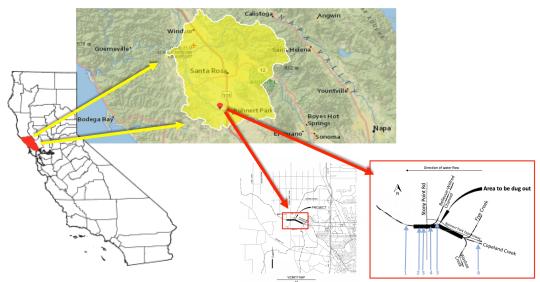Modifying stream channels to control invasive species
Modifying stream channels to control invasive species
Parts of the Laguna de Santa Rosa have become progressively shallower over the years as nutrient-rich sediment has washed downstream, slowed down and settled out. These wide, shallow, and sunny channels are suitable habitat for the invasive weed, Ludwigia hexapetala, which has completely overgrown parts of the Laguna. Sonoma Water plans to dig out sediment from the Laguna near Stony Point Road in Rohnert Park as part of their Water Quality Credit Trading Program. The digging project has resulted in a narrower, deeper, more shaded channel. We identified six study sites in the area that had sediment removed. At each site, we have characterized water depth, amount of canopy cover, and plant types present, and have gathered aerial images of each site using a drone. Moving forward, we will monitor these sites each semester to assess whether the new deeper channel design will prevent Ludwigia growth and improve habitat health.
| Title | Format | Download | Students |
|---|---|---|---|
| "Characterizing the Laguna de Santa Rosa at Stony Point Road Prior to Sediment Removal" | poster | Joseph Adams, Aurora Alexander, Max Belote-Broussard, Amanda Brewer, Justin Brown, Max Dumstorff, William Kendrick, Evan Lieberman, Kayla Nelson, Kyle Page, Sinoun Phoung, Mariah Rivera, Jailene Sotelo, Michael Stone, Lydia Vass, Dakota Whitman, Irina Zhuravskaya | |
| Canopy cover, water depth, species along transects at 6 sites - Fall 2018 | data | ||
| Complied water data | data |
Keywords: wetlands, transect survey, drone, Laguna de Santa Rosa
Project Date:
2018 to present
Faculty:
- Jackie Guilford
Departments:
- Biology
Partners:
- Sonoma Water
Students:
- GEP 359
Locations:
- Sonoma County
Project Topics:
- Biodiversity
- Land Use
- Water
Funding Sources:
- Waters Collaborative







